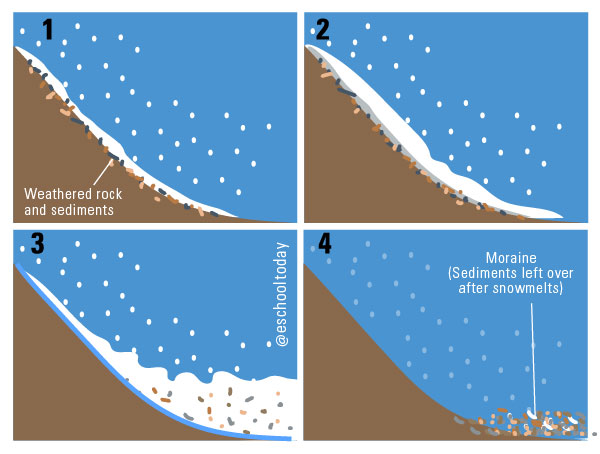- Landforms
What is Glacier?
Glaciers are found in cold regions such as the Antarctica and Arctic regions, Greenland, and colder parts of Canada. In simple terms, a glacier is moving ice. It means the availability of snow and some slopes are conditions for glaciers to occur.
Consider the illustration below:

1— Glacier begins with lots and lots of snowfall in regions where the ice rarely melts. They fall on mountain slopes and over weathered rock material.
2— After many years of repeated snowfalls, the ice is compressed under its weight. The compact snow and ice become heavier with even more snowfall.
3— Sometimes, the land warms up and melts a thin layer of the rock surface and the solid ice and snow. That causes the ice to slide and crush under its weight. As they move along the mountain slope, they break off rocks on the surface (abrasion) and carry them downhill.
4— When the ice melts, rocks, sand, clay, and all the debris are left behind to form a moraine. In colder climates, the ice never melts, even after the move downhill. Sometimes they end up in the seas and float on the water surface.
There are four types of glaciers:
- Ice sheets:
These are massive lands of ice that cover more than 20,000sq miles. The two major ice sheets today can be found in Greenland Antarctica. These form in areas where the ice never melts. Year after year, snow piles on and is compacted under its weight. If there are slopes, the ice can glide down.
- Ice shelves:
These are slabs of ice floating on the cold seas but connected to a landmass. The slaps can also receive snow and keep building up. These form when ice sheets slide onto new seas.
- Ice caps:
This is ice that makes up the top parts of mountain areas.
- Icebergs:
These are smaller chunks of ice that form on land and break up into the ocean. They can grow in size as they collect more rain and snow. There can be very dangerous to ships as they can be hard to see from a distance.
